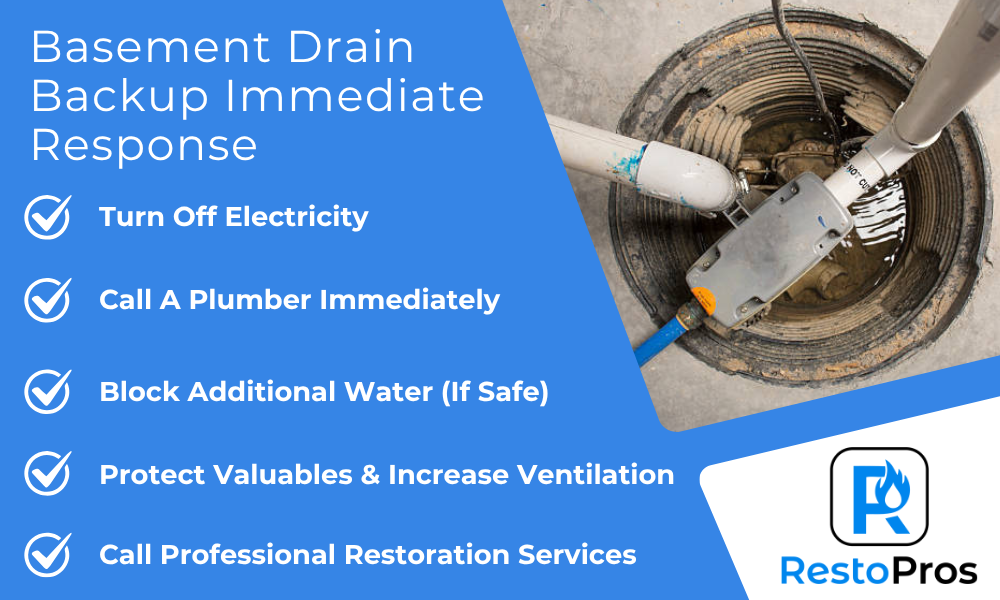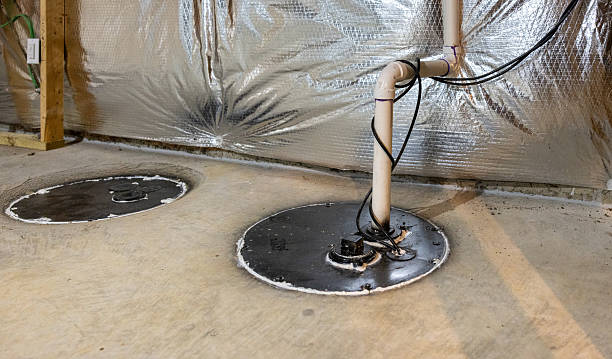The Short Answer: A basement drain backing up is usually caused by a clog in the drain line or sewer line, tree roots, or heavy rain overwhelming the system. To troubleshoot, start by checking for and clearing minor debris from the drain, then try a plunger or a drain snake for clogs. If the problem persists, turn off any water-using appliances, check if other drains in the house are also backed up, and call a plumber, as the issue may be a more serious blockage or a broken pipe.
Once the plumbing issues are resolved, RestoPros steps in to handle the water damage. When a basement drain backup occurs, contaminated water can quickly flood your basement, causing potential structural damage and health hazards. A backed-up floor drain often announces itself through warning signs like gurgling sounds from drains, water pooling around basement floor drains, or foul odor from sewage backup. This situation creates immediate risks to your health and property. Contaminated water can contain harmful bacteria, while prolonged exposure threatens your basement’s structural integrity and can lead to mold growth within 24-48 hours.
The restoration process focuses on three main phases after the drainage system issue is resolved. First, professional water extraction removes standing water and excess water from the affected area and sewage backup. Next, industrial-grade equipment dries and dehumidifies the space. Finally, thorough cleaning and sanitization make your basement safe again. RestoPros brings professional equipment and trained technicians to handle this process efficiently, protecting your property from further damage.

Understanding Basement Drain Backups
A basement drain backup occurs when wastewater flows backward through your drain line into your basement, usually due to sewer line clogs or system overload during heavy rainfall. This situation requires immediate attention from a professional plumber as the resulting water damage can harm your property’s structure and create health risks from contaminated water.
Common Causes of Drain Backups
Sewer line clogs form when tree roots, debris, or grease accumulate in the main sewer line, blocking the normal flow of the drainage system. Heavy rainfall overwhelms municipal sewer systems, forcing sewage backup through basement floor drains. Plumbing system capacity problems happen when old pipes can’t handle excess water from multiple plumbing fixtures or severe weather.
Water Contamination Classifications
Category 1 (Clean Water): Comes from broken water supply lines or overflowing kitchen sink with no contaminants. This poses minimal health risk but can escalate to Category 2 if left standing.
Category 2 (Gray Water): Contains mild contaminants from washing machines, dishwashers, or toilet overflow with no feces. This water carries some health risks and can degrade to Category 3 within 48 hours.
Category 3 (Black Water): Highly contaminated water from sanitary sewer backup or flood waters. This water contains dangerous bacteria and pathogens requiring immediate professional cleanup.
Property Risk Assessment
Water damage affects your basement’s structure within hours. Drywall absorbs water and begins to swell, while wooden supports can warp and weaken. Metal fasteners start corroding, compromising structural integrity.
Basement contents face rapid damage:
- Electronics short-circuit immediately
- Fabric items absorb contaminated water
- Paper goods become unsalvageable
- Stored items develop rust and staining
Mold development begins between 24-48 hours in damp conditions. Without proper drying and cleanup, mold spreads through organic materials, requiring additional remediation costs and potentially causing health issues for occupants.

Immediate Response Steps
Safety First: Protect Yourself and Others
Turn off electricity to the affected area and the basement if you can safely reach the breaker box. Never enter standing water in a basement where electrical outlets, plumbing fixtures, or wires may be submerged. Wear protective boots, gloves, and a face mask, as sewage backup often contains harmful bacteria. If you smell a foul odor, suspect sewer backup, or notice drainage issues, evacuate immediately and call emergency services.
Document Everything
Take clear photos and videos of the basement drain backup before cleanup begins. Capture the water damage, affected items, and visible structural damage to walls, basement floor, and belongings. Create a detailed list of damaged items, including brand names, purchase dates, and estimated values. Note exactly when you discovered the drain backup and any relevant events like heavy rainfall leading up to it. This documentation helps support insurance claims.
Take Quick Action to Minimize Damage
First, contact a plumber immediately to address and stop the source of the water issue. RestoPros cannot fix plumbing problems, but once the plumber has resolved the underlying cause, we can help mitigate the damage caused.
While waiting for the plumber, if safe, try to stop excess water from entering by blocking the drain with sandbags or heavy plastic. Move valuable items to higher ground if possible without risking personal safety. Open windows and doors to increase air circulation, which helps slow mold growth. Don’t use household vacuums to remove water; they aren’t designed for sewer backup cleanup and could cause electrical hazards.
Avoid starting repairs yourself beyond these basic preventative measures. Professional water damage restoration requires specialized equipment and expertise. Once the plumber has stopped the water issue, contact RestoPros emergency response team, who can properly assess the drainage system and begin proper mitigation procedures that prevent additional property damage while keeping you safe.
Professional Restoration Process for Water Damage
Initial Assessment and Planning
When water damage occurs in affected areas, RestoPros technicians start with a thorough property evaluation. Our team uses moisture meters and thermal imaging to map drainage issues and determine water penetration levels. This scientific approach helps us plan the exact equipment needed and establish proper drying zones.
Advanced Water Removal
Our technicians deploy commercial-grade extraction equipment to remove excess water quickly. We use:
- Powerful submersible pumps for deep water
- Professional vacuum units for surface water
- Specialized floor drain systems for hardwood
- Targeted extractors for carpets and padding
Precision Drying Process
After water removal, we position air movers and industrial dehumidifiers based on our drainage system mapping data. This creates optimal airflow patterns and removes water vapor efficiently. Our team adjusts equipment daily based on moisture readings to achieve complete drying.
Documentation and Monitoring
Throughout restoration, we maintain detailed records including:
- Daily moisture level measurements
- Photos of drying progress
- Equipment placement diagrams
- Temperature and humidity data
This documentation helps validate our work methods and supports insurance claims for property damage. We track readings until materials return to normal moisture content, typically requiring 3-5 days of monitored drying.

Restoring Your Peace of Mind: Next Steps & Prevention for Basement Drain Backup
When facing a backed-up basement drain, prompt professional plumber assistance prevents potential damage to your property and belongings. RestoPros’ emergency response team provides rapid water damage removal, thorough drying, and complete drainage system restoration services to protect your home’s structural integrity.
After our team completes water extraction and structural drying, we continue monitoring moisture levels throughout your basement floor to prevent secondary issues like mold growth. Our certified technicians document every step for your insurance claim and coordinate directly with your insurance provider. We understand a sewage backup disrupts your life, which is why our team works efficiently to restore your affected area to its pre-loss condition.
Don’t wait until drain backup starts occurring; contact RestoPros immediately at 803-850-6100. Our emergency response team arrives within 60 minutes, 24 hours a day, 365 days a year. We offer free damage assessments and work with all major insurance providers to reduce your stress during this challenging time. Let our experienced restoration professionals handle the cleanup while you focus on getting your life back to normal.
